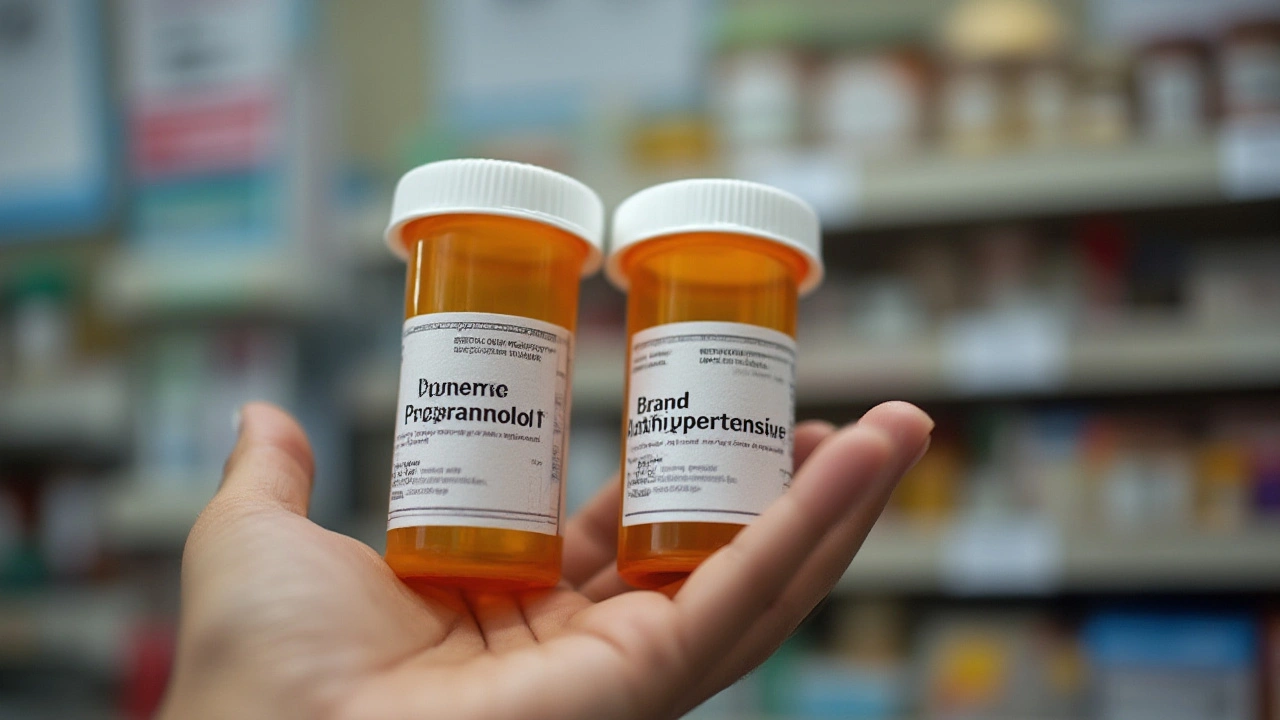If you’ve ever stared at your pharmacy bill and wondered whether another blood pressure pill could save you a bit of cash, you’re definitely not alone. In Brighton, just like everywhere else, prescriptions for hypertension can feel like a game of roulette with your wallet. NHS might handle a lot, but what about those unexpected costs when insurance doesn’t cover everything? And what if you’re stuck weighing generic propranolol against the latest ACE inhibitor, wondering why one costs less but claims just as much punch?
Comparing Out-of-Pocket Costs: Propranolol’s Reputation for Affordability
Let’s start with a number that might surprise you: in 2025, a month of generic propranolol—one of the oldest but reliable beta-blockers out there—can cost as little as £3 to £6 with an NHS prescription in the UK. If you’re buying out-of-pocket from a private pharmacy, you might pay around £7–£12, depending on the dose and pack size. It’s even lower if you get it through a repeat prescription arrangement. For folks in the States or without NHS, the price climbs: without insurance, US chain pharmacies often charge $10–$20 for a one-month supply, though prices vary city to city.
Why does propranolol keep things so cheap? Two reasons: age and generics. Since it’s been around since the 1960s, it’s off-patent, which means anyone can make it. Compare that with a newer antihypertensive, like amlodipine (a calcium channel blocker): while its price has dropped in recent years, it’s still usually a notch higher than propranolol. Losartan, an angiotensin receptor blocker, sits in a similar ballpark, with a standard UK price of about £6–£9 for a month’s supply, but private purchase can sometimes nudge £15.
Now think about how your prescription costs stack up for other common meds. ACE inhibitors like enalapril or ramipril run about the same as propranolol on the NHS—£9.65 per item (the current standard prescription charge)—but in private pharmacies, they can double or triple in price, especially if your insurance or discount card doesn’t chip in. Now imagine you’re dealing with a branded drug like Nebivolol (Bystolic in the US); that’s when the costs can skyrocket, running £30 or more per month if you’re unlucky or uninsured. That’s not even touching the price tags for combination blood pressure drugs.
One quick tip: always check both your local NHS options and reputable online pharmacies, especially if you find yourself falling through the cracks (if you’re a student, for example, who just moved or hasn’t gotten NHS registration sorted). Asking your pharmacist if a cheaper equivalent is available can sometimes knock several quid off your monthly spend. Don’t forget to check for bulk discounts—buying three-month supplies at once (if your GP allows) can shave more off your overall cost.
Insurance Tiers & Coverage: How the Fine Print Impacts Your Wallet
Ever flipped through your insurance policy info and felt more confused than before? You’re not the only one. The way drugs are ‘tiered’ in insurance formularies decides just how much you’re digging into your pocket. In the UK, most essential antihypertensive medications make the NHS formulary; you pay the set prescription charge (currently £9.65 per item), unless exempt. Simple enough. But private health plans—especially in the US—sort meds into tiers. The lower the tier, the less you pay. Generics like propranolol nearly always fall into tier 1, meaning the lowest co-pay. That’s a massive win for your budget.
Let’s look at US insurance tiers as a quick explainer:
- Tier 1 (Generic Drugs): Lowest out-of-pocket costs, often $4–$15 per script per month.
- Tier 2 (Preferred Brand): Moderate co-pays, $20–$50/month.
- Tier 3 (Non-Preferred Brand): Higher co-pays, sometimes $75–$100+.
- Specialty Tier: Usually expensive, newer drugs—co-pays can go wild here (some push $500 or more per month).
So how does this shake out for blood pressure meds? Generic propranolol, amlodipine, losartan—these usually occupy tier 1. That’s not just good news for ongoing cash flow; it makes these drugs a safe bet if you’re at risk of losing coverage or switching insurers. Branded beta-blockers, ARBs, or fixed-dose combinations? Those often sit in tier 2 or tier 3, sometimes requiring “prior authorisation” (ie, red tape and headaches) or simply sticking you with the full cost if coverage is denied.
One overlooked detail: insurance plans sometimes restrict how much of each drug you can purchase at once. Suppose you travel often, or you’re planning to be away from Brighton for a while (say, a working holiday in Spain). That can make a difference. For tier 1 generics, most plans allow for a 90-day supply, which can mean one flat co-pay instead of three payments—definitely worth asking about.
Do you qualify for the NHS medical exemption certificate, or the NHS Low Income Scheme? If you have a chronic condition requiring long-term medication, you might pay nothing at all. In the US, check if your employer offers a prescription discount card, or see if the insurer runs a mail order pharmacy—it can carve a decent chunk off what you’d pay in-store.

Discount Programs and Pharmacy Strategies: Squeezing More Value from Every Pound (or Dollar)
Discount programs can feel a bit like a maze, but mastering them turns you from a passive prescription-filler into a savvy deal-hunter. In the UK, the NHS prepayment certificate is an underused gem: pay £31.25 for three months or £111.60 for 12, and collect as many NHS scripts as you need (handy if you’re juggling multiple meds for hypertension plus, say, cholesterol or anxiety). For students or low-income earners, the NHS Low Income Scheme might mean free scripts altogether. Don’t skip those forms—every penny counts.
Now, if you’re in the US or ordering from abroad, pharmacy chains like Walgreens, Walmart, and CVS run $4 generic programs. That covers a basic three-month supply of many core antihypertensives, including propranolol, amlodipine, and lisinopril. Pill splitting can sometimes save you cash, too (with your doctor’s go-ahead): if a 40mg tablet costs the same as a 20mg one, you can halve them and stretch your prescription twofold.
Online pharmacies have changed the game in the last two years. I’ve had mates in Brighton order bulk propranolol online for overseas travel, slicing the per-month cost to under a fiver (GBP) including shipping, from licensed outfits. Just look out for the accreditation logos; steer clear of too-good-to-be-true offers. And for those worried about medication shortages or insurance denials, here’s a handy link covering the subject of propranolol substitute choices—sometimes the next best thing for your wallet actually works just as well for your health.
Don’t forget loyalty points if you buy over-the-counter supplements or devices from your pharmacy. Boots, Superdrug, and Lloyds all have points schemes, and those add up. Whisper it, but sometimes a little cashback through your credit card can take the sting out of a health bill, too.
Here’s a quick snapshot to show how the numbers can play out (prices are for illustrative purposes and may shift):
| Medication | NHS Cost/Month (UK) | Private Out-of-Pocket (UK) | US Generic Program Price (Month) | Common Insurance Tier |
|---|---|---|---|---|
| Propranolol (generic) | £9.65* | £7-£12 | $4-$10 | Tier 1 |
| Amlodipine (generic) | £9.65* | £8-£13 | $4-$12 | Tier 1 |
| Losartan (generic) | £9.65* | £10-£15 | $6-$15 | Tier 1/2 |
| Nebivolol (Bystolic) | £30+ | £30-£50 | $50+ | Tier 3 |
| Enalapril (generic) | £9.65* | £7-£14 | $4-$10 | Tier 1 |
*NHS set prescription price; may be free for those exempt.
Making the Right Choice: Factors Beyond the Sticker Price
Alright, so maybe cost is king when you’re juggling rent, food for a picky cat (looking at you, Mercury!), and life’s usual surprises. But there’s more to weigh up than just what the till spits out. Some people tolerate beta-blockers like propranolol brilliantly, but others wrestle with cold hands, tiredness, or the occasional vivid dream. In that case, spending a few quid more on amlodipine (which can cause ankle swelling instead) or losartan (less likely to mess with your heart rate) may make life smoother, even if it stretches the budget.
Your GP or pharmacy team can sometimes tweak your prescription for better value: different pack sizes, changing to less common but equally effective generics, or using one pill that covers more than one issue (such as a combo antihypertensive/diuretic). It’s worth exploring side effect profiles and how they mesh with your other health needs, too. For instance, if you get migraines or social anxiety on top of hypertension, beta-blockers like propranolol can tick a few boxes at once—and that can cut down your overall medicine costs and hassle factor.
More people these days are splitting scripts across pharmacies: picking up their antihypertensive from the cheapest local option, but buying rare or hard-to-find meds online. Just keep your GP in the loop to avoid gaps or mix-ups. Loyalty isn’t rewarded as much as it used to be; shop smart, not just from habit.
Don’t underestimate the impact of small savings over twelve months. Switch from a branded antihypertensive to a generic and you might keep an extra £200-£400 in your pocket each year. Add in the multipurpose value of drugs like propranolol—used for blood pressure, heart rate, migraine, anxiety, even certain tremor disorders—and suddenly, one humble tablet covers a lot of ground for not much money.
Cutting through the brand names, insurance-speak, and pharmacy jargon makes a real difference for anyone keeping tabs on chronic health costs. If you feel stuck, or your wallet’s taking a hit, don’t just accept the price as fixed—there’s always another discount, another generic, or another pharmacy ready to offer a better deal. Keep your eyes open, ask questions, and remind your doctor that value matters as much as going with the default prescription. Turns out, the biggest difference in blood pressure management doesn’t always come from what’s inside the pill—it comes from finding the one that delivers results without emptying your wallet.


Written by Felix Greendale
View all posts by: Felix Greendale